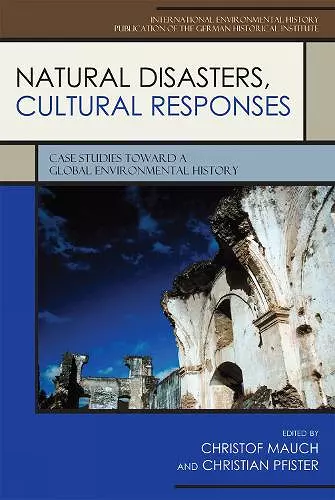Natural Disasters, Cultural Responses
Case Studies toward a Global Environmental History
Christian Pfister editor Christof Mauch editor
Format:Paperback
Publisher:Bloomsbury Publishing PLC
Published:16th Feb '09
Currently unavailable, and unfortunately no date known when it will be back

Catastrophes, it seems, are becoming more frequent in the twenty-first century. According to UN statistics, every year approximately two hundred million people are directly affected by natural disasters—seven times the number of people who are affected by war. Discussions about global warming and fatal disasters such as Katrina and the Tsunami of 2004 have heightened our awareness of natural disasters and of their impact on both local and global communities. Hollywood has also produced numerous disaster movies in recent years, some of which have become blockbusters.
This volume demonstrates that natural catastrophes—earthquakes, hurricanes, floods, etc.—have exercised a vast impact on humans throughout history and in almost every part of the world. It argues that human attitudes toward catastrophes have changed over time. Surprisingly, this has not necessarily led to a reduction of exposure or risk. The organization of the book resembles a journey around the globe—from Europe to North Africa, the Middle East, and Asia, and from the Pacific through South America and Mexico to the United States. While natural disasters appear everywhere on the globe, different cultures, societies, and nations have adopted specific styles for coping with disaster. Indeed, how humans deal with catastrophes depends largely on social and cultural patterns, values, religious belief systems, political institutions, and economic structures. The roles that catastrophes play in society and the meanings they are given vary from one region to the next; they differ—and this is one of the principal arguments of this book—from one cultural, political, and geographic space to the next. The essays collected here help us to understand not only how people in different times throughout history have learned to cope with disaster but also how humans in different parts of the world have developed specific cultural, social, and technological strategies for doing so.
Edited by the acknowledged masters of environmental history, Christof Mauch and Christian Pfister, this absorbing collection enriches our understanding of how humans at different times and in different places have dealt with disasters. The unexpected and dramatic hazards of life on earth—earthquakes, floods, drought, frost and fires—have brought real suffering, death, famine, and disease to rich and poor, rural and urban alike. However, as the expert contributors to this book demonstrate so persuasively from historical case studies around the world, they have also produced particular situations that have generated innovative socio-political, technological and economic coping strategies. This is an informative and thought-provoking book, not only for its wealth of information and enormous contribution to the growing field of disaster history, but it is a timely publication for an era in which human beings, perhaps more than at any other period in history, feel vulnerable in the face of growing anthropogenic catastrophe. -- Jane Carruthers, University of South Africa
An intriguing collection of essays that examine environmental history through the lens of natural disasters that have occurred around the world... informative...absorbing to read and ponder... highly recommended. * History In Review *
This well-done collection broadens and deepens our understanding of the history of disasters considerably.... The book is an important stepping stone in the globalization of environmental history. * H-Net: Humanities and Social Science Reviews Online *
Floods, famines, earthquakes, and other disasters have wrought havoc throughout history. This book presents studies ranging from Finland to the Philippines, and from medieval times until today, to show the diversity of human responses to terrible catastrophes. Everyone interested in the uneasy relationship between nature and culture will want to read this book. -- J. R. McNeill, Georgetown University
ISBN: 9780739124161
Dimensions: 229mm x 157mm x 28mm
Weight: 594g
394 pages